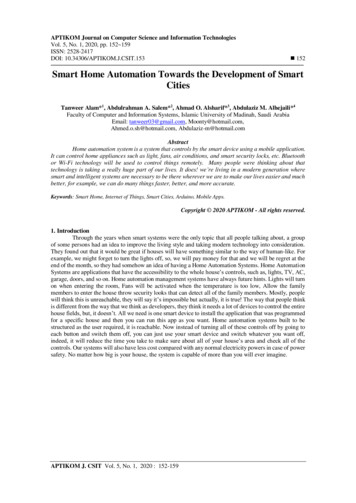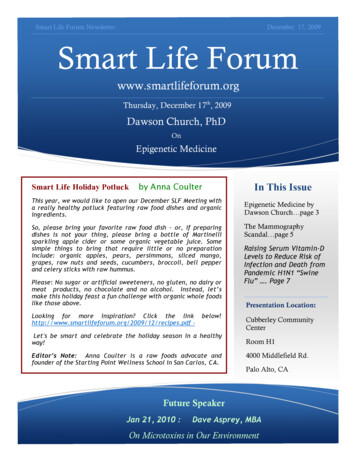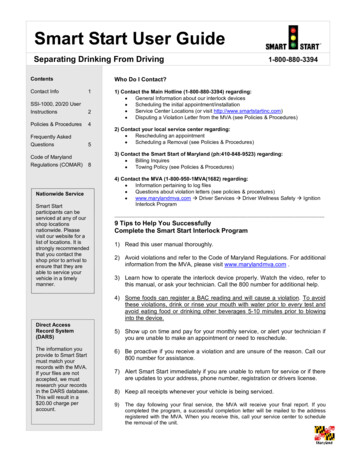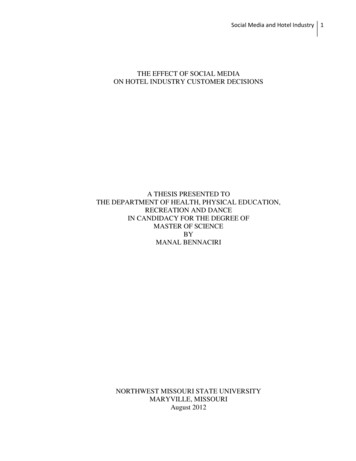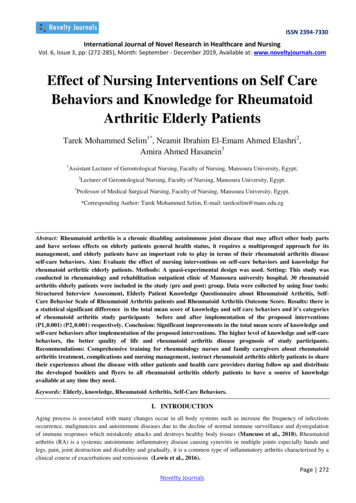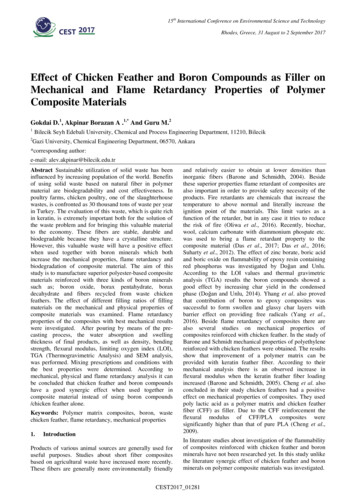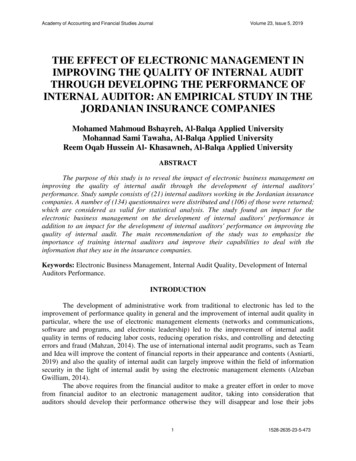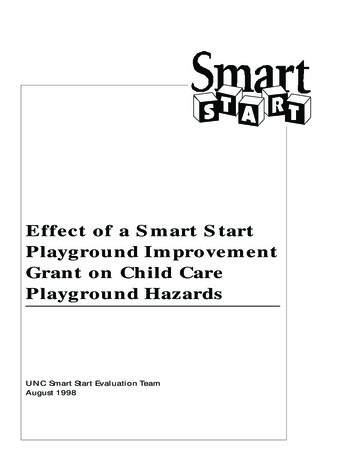
Transcription
Effect of a Smart StartPlayground ImprovementGrant on Child CarePlayground HazardsUNC Smart Start Evaluation TeamAugust 1998
E FFECT OF A S MART S TART P LAYGROUND I MPROVEMENT G RANTON C HILD C ARE P LAYGROUND H AZARDS 1998 FPG Child Development CenterJonathan Kotch and Christine GuthrieDepartment of Maternal and Child HealthSchool of Public HealthUniversity of North Carolina at Chapel HillThe authors wish to thank Dee Gray, Beth Partington and Adam Zolotor for their work in developing,field testing and implementing the playground safety survey.For additional copies of this report and other Smart Start evaluation reports, contact Marie Butts at theFrank Porter Graham Child Development Center, 105 Smith Level Road, CB# 8180, UNC-CH,Chapel Hill, NC 27599-8180 or call (919) 966-3871.500 copies of this document were printed at a cost of 446.00, or .90 per copy.
IntroductionThe North Carolina Early Childhood Initiative, better known as SmartStart, is a partnership among state government, local leaders,service providers, and families to better serve young children. The main goal ofSmart Start is to ensure that all children enter school healthy and prepared to succeed.Smart Start’s innovative approach requires that local community partnerships plan howbest to meet the needs of children and families, by improving and expanding existingprograms and/or designing and implementing new programs. Using funds allocated bythe state legislature and additional funds contributed by the private sector, each partnership is working to improve the quality of child and family services.All partnerships are obliged to spend no less than 70% of their resources on improvingthe availability, accessibility, and quality of child care. Given that recent studies in thehealth and child care literature have called attention to the safety of young children inout-of-home care, twenty five of Smart Start’s 47 partnerships (as of this writing) havechosen to spend some of their funds on reducing injury hazards on child care playgrounds. These 25 partnerships have allocated 4,165,763 for playground improvement projects since the initiation of Smart Start. The projects have included playgroundsafety assessment, planning and evaluation, quality enhancements (such as fencing,surfacing, and/or new equipment), and safety programs. In this report, the results ofvisual inspections of child care home and center playgrounds in a Smart Start countywhich invested 675,000 to improve child care playground safety are compared withthe results of similar inspections in a non-Smart Start county.
Effect of a Smart Start PlaygroundImprovement Grant on Child CarePlayground Safety HazardsBackgroundConcern for the safety of children in out-of-home care is growing along with thenumber of such children. Studies of injuries among children in child care centershave demonstrated that most injuries occur on playgrounds and are the results of fallsaffecting the head and upper limbs. Such injuries appear to be related to reversiblehazards on child care playgrounds.Executive SummaryMethodologyThe Durham County Partnership for Children allocated 675,000 to the Durham DayCare Council for playground safety enhancements in child care centers and familychild care homes in the county. Some of this money was spent on child care playground hazard reduction. The Frank Porter Graham Smart Start Evaluation teammatched 17 child care facilities in Durham which used playground safety improvement grants with 17 similar facilities in Alamance County, a non-Smart Start county.Specially trained playground safety inspectors completed structured playgroundsafety surveys in all 34 child care facilities. The results were analyzed using t-testsand general linear modeling techniques.ResultsOn each of 15 safety criteria, the Durham facilities were rated higher than theAlamance facilities. Eleven of these differences were statistically significant. Facilities were separated according to whether they were homes or centers, and theDurham facilities again scored consistently higher. Thirteen centers in Durham andno centers in Alamance were licensed at the AA level, but even when this differencewas taken into account, the results significantly favored the Smart Start centers inDurham. Six of the differences, including the total playground safety score, werestatistically significant.
DiscussionThe outcomes of this study demonstrate that improved child care playground safety isrelated to receipt of Smart Start playground improvement grants. This study alsodemonstrated the feasibility of conducting abbreviated playground safety surveys withminimal demand on the time of child care staff. A limitation of this study is the lackof a pre-test. It seems logical to conclude that playground safety improvementsresulting from Smart Start grants can reduce the injury rate among children, althoughanswering this question will require a longitudinal study of a larger number of childcare centers.Executive Summary
6S MART S TART PLAYGROUND IMPROVEMENTEffect of a Smart Start PlaygroundImprovement Grant on Child CarePlayground Safety HazardsB ACKGROUNDIn response to concern for the safety of the growing number of children in out-of-homecare, some researchers and policy makers have looked at the numbers and rates ofinjuries at child care centers. Others have studied hazards or the adherence to playground safety standards in child care centers or family child care homes. Still othershave sought to obtain a comparison of the rate of injuries in out-of-home care versusown-home care in an attempt to answer the question, “Is out-of-home care as safe asown-home care?” These three approaches will be discussed in turn.Studies have categorized child care injury by type and severity, cause of injury, site ofinjury, body part injured, day of injury, and season of injury. Most have looked only atinjuries that received medical attention. Only two studies attempted to identify minoror non-medically attended injuries. 1, 2 Rates of injury have been calculated for allinjuries in general and also for injuries by severity and age and sex of children. Somecommon conclusions that researchers have drawn are: falls, both indoor and outdoor, account for the largest proportion of injuries 47–67% of injuries occur on the playground the most severe injuries, such as fractures and concussions, occur as a resultof falls from playground equipment the peak season for injuries is summer peak times of day for child care injury are late morning and mid-afternoon major body parts injured are the head and upper limbs.Two studies noted that 88–90% of injuries were minor.3, 4 Chang and coworkers alsorecorded that the risk of injury was somewhat higher for boys than girls, particularlyyounger boys (2 to 3 years of age).4Studies of adherence to playground safety recommendations include two from NorthCarolina. The first, a national survey of child care regulators, concluded that adherenceto national child care safety standards, as those promulgated by the American Association of Pediatrics and the American Public Health Association among others,5 was very
UNC S MART START E VALUATION7variable.6 A second study of a random sample of North Carolina child care centersspecifically demonstrated that, although center directors reported a wide range ofcompliance with the same standards, compliance was best when a standard wasreflected in a state regulation.7Early reports of hazards and injuries in child care centers (1983-1988) seemed tosuggest that centers and family child care homes were unsafe.8, 9 A few researchers havetried to challenge this assertion. Rivara and coworkers concluded that child carecenters were at least as safe as home environments, if not safer.10 Similarly, Sacks andothers found injury rates in 71 Atlanta child care centers to be lower than publishedchild injury rates for the general population of preschool children.11 Gunn and colleagues arrived at a similar conclusion.12 However, Kopjar and Wickizer conducted alarge, prospective study looking at child care and home care injury in Stavanger,Norway. They concluded that for children aged 6 months to 2 years, the risk of injury ishigher at home, but for children ages 3 to 6 years, the risk of injury at child care centersis similar to the risk of injury at home (1.3 and 1.5, respectively, per 100,000 childhours).13 In other words, for the older age group, child care is no safer than home care.Kotch et al. (1997) also concluded, in their telephone survey study of three counties inNorth Carolina, that the rate of serious injury in child care centers is not different fromthe rate of injury occurring in children’s own homes.2M ETHODOLOGYIdeally, children in a safe, professionally supervised environment should experiencelower overall injury rates than children cared for at home. Children cared for at homeare exposed to both home injury hazards and the risk of motor vehicle injury whileaccompanying parents on errands. On the other hand children in out-of-home care,particularly those in centers, are in facilities subject to health and safety inspections atleast once a year for licensing purposes. Mindful that child care playground safetycould be improved, the Durham County Partnership for Children allocated 675,000 tothe Durham Day Care Council to improve playgrounds in Durham County child carecenters and child care homes. Distribution of the funds was at the discretion of theCouncil. The Frank Porter Graham Smart Start Evaluation team was interested in usingthis opportunity as a case study applying a cross-sectional design to the evaluation of aSmart Start health intervention.PARTICIPANTSAll 17 child care facilities in Durham County that received Smart Start playground
8S MART S TART PLAYGROUND IMPROVEMENTquality enhancement grants from the Durham Day Care Council were recruited for thestudy sample. Alamance County, which was not a Smart Start county at the time, wasselected as the county from which to draw comparison playgrounds because of itsdemographic similarity and proximity to Durham. The child care facilities withinAlamance were selected on the basis of their ratings (AA, A, GS, or S), size (number ofchildren for which the center was licensed), acceptance or rejection of the purchase ofcare, the type of operator (church, independent, public, etc.), and the type of physicalfacility (converted house, built for child care, public school, etc.). Alamance centersand family child care homes were matched with their Durham equivalents based uponthe maximum number of similarities. There were insufficient numbers of AA centers inAlamance to use that criterion for matching.MEASURESMembers of the Smart Start Health Evaluation team, Frank Porter Graham’s Head StartQuality Research team, and a playground safety consultant designed the playgroundsafety audit form. The form was designed to address the most salient playground hazards while being relatively short, easy to learn, and easy to use. The content was basedon the U.S. Consumer Product Safety Commission’s (CPSC) playground safety guidelines and the American Society for Testing and Material’s (ASTM) “Standard ConsumerPerformance Specification for Playground Equipment for Public Use.” The audit formscontain age-appropriate guidelines for children ages 2 to 5 years old.In the interest of developing an instrument that could be applied in one hour perplayground, the designers nominated important elements of the CPSC and ASTMguidelines based upon characteristics such as “relative danger” and “commonness ofhazard.” A total of fourteen parameters were selected for evaluation. In order to use theaudit as an evaluation instrument, each parameter of the inspection received a score offrom one to three. A score of three meets the guideline for the parameter; a score of twosignifies minor violations of the guideline; a score of one reflects poor compliance withthe guideline. A summary of the items is included in the Appendix.PROCEDURESObservers were systematically trained in the use of the playground safety audit form.Training consisted of a 45 minute educational video presentation, two hours of classroom training, and three hours of applied playground training in the field. The reliability of the instrument was tested through a complete safety check of a local playgroundby the four safety inspectors in training (two Smart Start evaluators and two Head Start
UNC S MART START E VALUATION9quality researchers), including those who developed the instrument. The four inspectorsachieved consensus for all of the scores without consulting with each other. Thisprocess modeled techniques for the inspectors’ judging playground hazards and scoringthe parameters.All playground inspections for this study were performed by one of the two trained SmartStart inspectors, with the advance permission of the center director, and when no children were present on the playground. Standard templates for children’s head and torsomeasurements, and gauges to measure protrusions, were obtained from the Iron Mountain Forge, Farmington, Missouri. Reliability checks were completed for five centers andranged from 86% - 100%. The study was approved by the Institutional Review Board forthe Protection of Human Rights of the College of Arts and Sciences, UNC-CH.ANALYSISStudent’s t-tests were used for unadjusted comparisons of each of the 14 safety criteriaand total hazard scores for the Durham and Alamance child care facilities, and separately for centers and homes. In addition, general linear modeling was used to compareDurham and Alamance large homes and centers on the same criteria, controlling forlicensing level (A versus AA).RESULTSThere were 34 child care facilities inspected, 17 in each of the two counties. Twentyseven were centers, 4 were small child care homes, and 3 were large child care homes.Both types of homes were combined into a single category for analysis. (See Table 1.)On most descriptive criteria the Alamance and Durham facilities were similar. The onlyexception was licensing level. All of the AA centers were in Durham.There were 15 criteria for comparison, 14 individual criteria and a total. On each of the15 criteria, the Durham facilities had a higher mean score than did the Alamancefacilities. (See Figure 1.) Eleven of the fifteen differences were statistically significant atthe p 0.01 or p 0.05 level.The only descriptive characteristic with sufficient numbers in each category for separatecomparisons was home vs. center. When Alamance and Durham child care facilitieswere compared within each category, Durham facilities again scored consistentlyhigher. Controlling for type of facility (home vs. center), there were three significantdifferences (p 0.05) in both homes and centers, sharp points, surfacing, and total.
10S MART S TART PLAYGROUND IMPROVEMENTThere were an additional two significant differences in homes only and 8 in centersonly. (See Table 2.)Because the counties differed so much on licensing level (A vs. AA), the analysis wasrepeated using the general linear models procedure. After dropping the homes from theanalysis and controlling for licensing level, there were still six significant differences(three at p 0.05 and three at p 0.01) between Smart Start and comparison centers. Oneof these (p 0.01) was in total playground safety scores. All the differences favored theSmart Start centers. (See Table 3.)D ISCUSSIONOUTCOMESChild care facilities in a county that used Smart Start funding specifically for the purpose of upgrading playgrounds had fewer playground safety hazards than did matchedfacilities in a non-Smart Start county. The differences in all categories of hazard were inthe direction of safer playgrounds in the Smart Start county, and the majority of thesedifferences were statistically significant. Furthermore, the differences hold up evenwithin the sub-categories of homes and centers. These relationships do not “prove” thatSmart Start funding was the sole reason for the difference, since we do not havebaseline data with which to demonstrate that the differences in safety hazards did notexist prior to the playground safety enhancements in the Smart Start county. It is possible that something else, such as the disproportionate number of AA centers inDurham, could explain Durham’s higher playground safety ratings, since AA centers areby and large of higher quality than A centers. However, playground safety is not amongthe criteria used for determining a center’s licensing level, and the differences remainedeven after adjusting for licensing level. Therefore, these results are consistent with theexpectation that the Smart Start child care facilities which received playground safetyenhancement grants would have better safety scores.PROCESSIn the process of conducting this project, it was found that such an observational studyis feasible with minimal demands on the time of child care staff. In the future, it wouldbe preferable to elicit the cooperation of participating facilities in the study countybefore the monies are distributed and the improvements completed. Surely child carefacilities benefiting from playground safety enhancement grants would be willing toagree to participate in an evaluation before the first dollar changes hands. If possible, abaseline survey prior to playground improvements would be desirable.
UNC S MART START E VALUATION11It the case of the non-Smart Start county, providing a copy of the completed playgroundsafety assessment to participating centers and homes was a useful incentive, as allcounties anticipated that more rigorous playground safety regulations might be implemented in North Carolina. Having the results of the hazard survey would give thefacilities a head start should they have occasion to implement playground safety enhancements in the future.C ONCLUSIONSThis study has demonstrated that a brief playground safety audit is a reliable tool formeasuring and comparing child care playground hazards. Trained inspectors can usethe tool to measure playground safety hazards with little to no interference with children or staff. Hopefully, the tool can be modified further to permit child care staffthemselves to conduct their own periodic audits of child care playground safety.The results also suggest that playground safety enhancement grants, such as thoseallocated by the Durham Partnership for Children (Smart Start), may be associated witha statistically significant reduction in playground hazards. That there is an associationbetween playground hazards and injury has been shown in the US14, New Zealand15,and Canada16. There would not have been enough serious injuries in these two counties to justify a study of injury outcomes.There are several limitations to this study. First, the evaluation design is not ideal. Thestudy would have been strengthened had pre- and post-tests been administered in boththe study and the comparison counties. Second, the playground safety inspectorsshould have been blinded to the status of the counties. Finally, as mentioned above,injuries themselves were not measured, nor could they have been in so few facilities.Nevertheless, these data indicate that county involvement in Smart Start can contributeto the improvement of playground safety conditions, thereby reducing children’s risk ofunintentional injury. A longitudinal study of the relationship between playground safetyand child care injury is in its early stages.
12S MART S TART PLAYGROUND IMPROVEMENTR EFERENCES1. Sellstrom, E., Bremberg, S., & Chang, A. (1994). Injuries in Swedish day-carecenters. Pediatrics 6(2):1033–1036.2. Kotch, J.B., Dufort, V.M., Stewart, P., Fieberg, J., McMurray, M., & O’Brien, S,et al. (1997). Injuries among children in home and out-of-home care. InjuryPrevention 3:267–71.3. Cummings, P., Rivara, F.P., Boase, J., & MacDonald, J.K. (1996). Injuries andtheir relation to potential hazards i
Frank Porter Graham Child Development Center, 105 Smith Level Road, CB# 8180, UNC-CH, Chapel Hill, NC 27599-8180 or call (919) 966-3871. 500 copies of this docu
